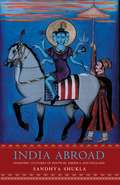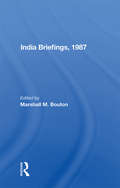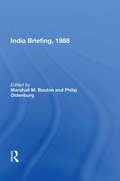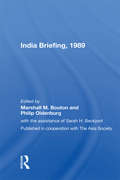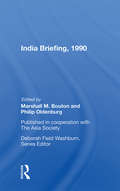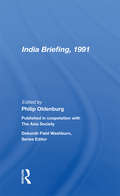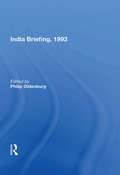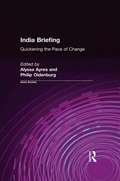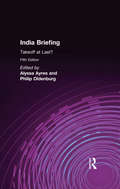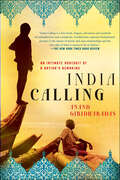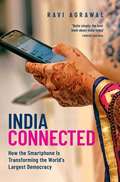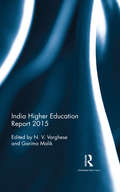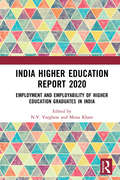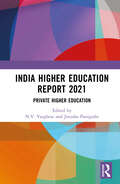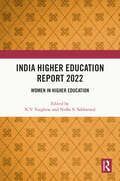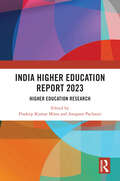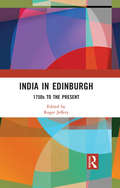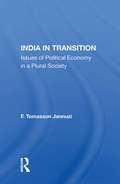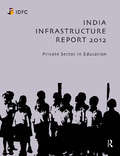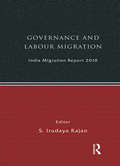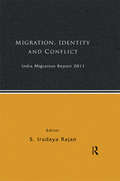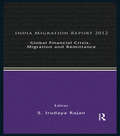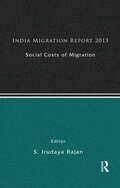- Table View
- List View
India Abroad: Diasporic Cultures of Postwar America and England
by Sandhya ShuklaIndia Abroad analyzes the development of Indian diasporas in the United States and England from 1947, the year of Indian independence, to the present. Across different spheres of culture--festivals, entrepreneurial enclaves, fiction, autobiography, newspapers, music, and film--migrants have created India as a way to negotiate life in the multicultural United States and Britain. Sandhya Shukla considers how Indian diaspora has become a contact zone for various formations of identity and discourses of nation. She suggests that carefully reading the production of a diasporic sensibility, one that is not simply an outgrowth of the nation-state, helps us to conceive of multiple imaginaries, of America, England, and India, as articulated to one another. Both the connections and disconnections among peoples who see themselves as in some way Indian are brought into sharp focus by this comparativist approach. This book provides a unique combination of rich ethnographic work and textual readings to illuminate the theoretical concerns central to the growing fields of diaspora studies and transnational cultural studies. Shukla argues that the multi-sitedness of diaspora compels a rethinking of time and space in anthropology, as well as in other disciplines. Necessarily, the standpoint of global belonging and citizenship makes the boundaries of the "America" in American studies a good deal more porous. And in dialogue with South Asian studies and Asian American studies, this book situates postcolonial Indian subjectivity within migrants' transnational recastings of the meanings of race and ethnicity. Interweaving conceptual and material understandings of diaspora, India Abroad finds that in constructed Indias, we can see the contradictions of identity and nation that are central to the globalized condition in which all peoples, displaced and otherwise, live.
India Briefing, 1987
by Marshall M. BoutonThis annual review of major events, issues, and trends in Indian affairs presents an authoritative and insightful assessment of India in 1986. Interpretive essays illuminate the causes and consequences of a tumultuous year, as leading specialists discuss Indian politics, economy, society, culture, and foreign relations. The contributors examine such important developments as the breakdown of the Punjab accord, the resurgence of militant communalism, Prime Minister Rajiv Gandhi's faltering leadership, the dramatic heightening of Indo-Pakistan tensions, the growing resistance to economic reforms, and the impact of the video revolution on Indian culture. Filling an important gap in the literature on contemporary Indian affairs, this book will be invaluable for students and scholars of South Asia as well as for journalists, policymakers, businesspeople, and serious travelers who wish to understand current and future developments in India.
India Briefing, 1988
by Marshall M. Bouton Philip OldenburgThis second volume in the series of annual assessments of key events and trends in Indian affairs offers an overview of Indian politics, economy, and foreign relations in 1987. It thoroughly examines important topics in Indian life, national security, science and technology, and education.
India Briefing, 1989
by Marshall M. BoutonIndia Briefing, 1989 is the third in a series of annual assessments of key events and issues in Indian affairs prepared by the Contemporary Affairs Department of The Asia Society. It covers the year's developments in Indian politics, foreign policy, and the economy.
India Briefing, 1990
by Marshall M. Bouton Philip OldenburgThis book aims to bring to readers an understanding of important developments in Indian affairs in 1990. It analyzes the role of resurgent Hinduism in India's political and social order and looks at the economy, foreign relations, law and poverty.
India Briefing, 1991
by Philip OldenburgThis book examines India's perception of its international role in relation to post-Cold War global realignment, describes social and literary movements among India's "Untouchables," and reviews the ongoing struggle over Kashmir. It presents comprehensive analyses of politics and the economy.
India Briefing, 1993
by Philip OldenburgA common theme in the India Briefing series has been India's resilience in the face of turmoil and tragedy. This year's volume demonstrates that India is under greater stress than ever before. In the country's severest test, India's secular foundations were shaken by the storming and destruction of the Barbi mosque in Ayodhya. This act of violence
India Briefing: 2001 (Asia Society Country Briefing Ser.)
by Philip Oldenburg Alyssa AyresIn the time between 1998 and the publication of this text, India held two national elections and began the second phase of economic reforms. This work examines these political, economic, social and cultural developments in India from 1998 to the end of 2000.
India Briefing: Takeoff at Last? (Asia Society Country Briefing Ser.)
by Philip Oldenburg Alyssa AyresSince 2001, India has gained new attention as an emerging world power with a rapidly growing economy, a world-class science and technology sector, and a huge English-speaking labor pool. After a period of escalating tension with neighbor Pakistan, wide-ranging peace talks are underway. Within India, there is an unprecedented mood of optimism about the future. At the same time, the nation wrestles with difficult questions about the place of secularism in society, the role it sees for itself globally and within Asia, and the reality that millions of Indians still live at the subsistence level. This volume of India Briefing examines India's changing fortunes through chapters that cover the economy; the twists and turns of domestic politics; labor in the large informal sector; the cultural roots of Hindu nationalism; the foreign relations rollercoaster; the business of Bollywood; and a special chapter on the range of new resources about India available on the web.
India Calling: An Intimate Portrait Of A Nation's Remaking
by Anand GiridharadasAnand Giridharadas sensed something was afoot as his plane from America prepared to land in Bombay. An elderly passenger looked at him and said, "We're all trying to go that way," pointing to the rear. "You, you're going this way?"Giridharadas was returning to the land of his ancestors, amid an unlikely economic boom. But he was more interested in its cultural upheaval, as a new generation has sought to reconcile old traditions and customs with new ambitions and dreams. In India Calling, he brings to life the people and the dilemmas of India today, through the prism of his émigré family history and his childhood memories of India. He introduces us to entrepreneurs, radicals, industrialists, and religious seekers, but, most of all, to Indian families. Through their stories, and his own, he paints an intimate portrait of a country becoming modern while striving to remain itself.
India Calling: An Intimate Portrait of a Nation's Remaking
by Anand GiridharadasReversing his parents’ immigrant path, a young American-born writer returns to India and discovers an old country making itself new.Anand Giridharadas sensed something was afoot as his plane from America prepared to land in Bombay. An elderly passenger looked at him and said, “We’re all trying to go that way,” pointing to the rear. “You, you’re going this way?” Giridharadas was returning to the land of his ancestors, amid an unlikely economic boom. But he was more interested in India’s cultural upheaval, as a new generation has sought to reconcile old traditions and customs with new ambitions and dreams.In India Calling, Giridharadas brings to life the people and the dilemmas of India today, through the prism of his émigré family history, introducing us to entrepreneurs, radicals, industrialists, and religious seekers, and, most of all, to Indian families. Through their stories, and his own, he paints an intimate portrait of a country becoming modern while striving to remain itself.Praise for India Calling“A fine book, elegant, self-aware and unafraid of contradictions and complexity. Giridharadas captures fundamental changes in the nature of family and class relationships and the very idea of what it means to be an Indian.” —The New York Times Book Review“[A] smart, evocative and sharply observed memoir . . . Giridharadas’s narrative gusto makes the familiar fresh.” —The Wall Street Journal“[A] readable, intriguing book . . . [Giridharadas is] a marvelous journalist—intrepid, easy to like, curious . . . India Calling connects us to a new India, and an engaging new voice.” —The Plain Dealer (Cleveland)
India Connected: How the Smartphone is Transforming the World's Largest Democracy
by Ravi AgrawalIndia is connecting at a dizzying pace. In 2000, roughly 20 million Indians had access to the internet. In 2017, 465 million were online, with three new people logging on for the first time every second. By 2020, the country's online community is projected to exceed 700 million; more than a billion Indians are expected to be online by 2025. While users in Western countries progressed steadily over the years from dial-up connections on PCs, to broadband access, wireless, and now 4G data on phones, in India most have leapfrogged straight into the digital world with smartphones and affordable data plans. What effect is all this having on the ancient and traditionally rural culture dominated by family and local customs? Ravi Agrawal's book explores that very question, seeking out the nexuses of change and those swept up in them. Smartphones now influence arranged marriages, create an extension of one's social identity that moves beyond caste, bring within reach educational opportunities undreamed of a generation ago, bridge linguistic gaps, provide outlets and opportunities for start-ups, and are helping to move the entire Indian economy from cash- to credit-based. The effects are everywhere, and they are transformative. While they offer immediate access to so much for so many, smartphones are creating no Utopia in a culture still struggling with poverty, illiteracy, corruption, gender inequality, and income disparity. Internet access has provided greater opportunities to women and altered how India's outcasts interact with the world; it has also made pornography readily available and provided an echo chamber for rumor and prejudice. Under a government determined to control content, it has created tensions. And in a climate of hypernationalism, it has fomented violence and even terrorism. The influence of smartphones on the world's largest democracy is pervasive and irreversible, disruptive and creative, unsettling and compelling. Agrawal's fascinating book gives us the people and places reflecting what the internet hath wrought. India Connected reveals both its staggering dimensions and implications, illuminating how it is affecting the progress of progress itself.
India Disasters Report II: Redefining Disasters
by S. Parasuraman Unni KrishnanIndia Disasters Report II highlights the reality of disaster vulnerability in India due to natural causes and developmental interventions. It emphasizes the need to look at disasters as an outcome of processes rather than stand-alone events. Adopting a multidisciplinary approach, this Report emphasizes the importance of understanding the causes, effects, and complex dynamics of disasters. It asserts the need to link natural systems, social systems, and technological limitations to devise policies and action plans for disaster prevention, relief operations, and environmentally-inclusive development. With climate change becoming a global concern, India now has laws and policies, national, state, and district level administrative set-ups, and humanitarian initiatives in place for disaster preparedness and response measures. Exploring diverse issues such as vulnerability, development, environment, gender, health, and information, communication, and technology, in disasters, this Report discusses recent disasters in India and how new thinking affects policy initiatives and actual practice in disaster management.
India Higher Education Report 2015
by N. V. Varghese Garima MalikThe unprecedented expansion of higher education in India and the proliferation of providers in turn have posed enormous challenges to equity, quality and financing of the sector. The India Higher Education Report 2015 traces the evolution of higher education and discusses the key role of committees and commissions whose reports and recommendations form the backdrop of contemporary developments. Authoritative and comprehensive, the volume examines a range of themes including equity, financing, employment, quality, and governance. It also engages with new and recent data as well as current issues and debates. The volume will be an important resource for academics, policy makers, civil society organisations, media and those concerned with higher education. It will also be useful to scholars and researchers of public policy, sociology and economics.
India Higher Education Report 2020: Employment and Employability of Higher Education Graduates in India
by N. V. Varghese Mona KhareIndia Higher Education Report 2020 critically analyzes the role played by the state, industries, and higher education institutions in the employment and employability of educated youth in India. The book discusses a wide range of topics such as employability skill gaps of higher education graduates; curriculum and skills training systems; formal and informal modes of skill formation; crisis of jobless growth in India; migration, education and employment; dimensions of gender, caste and education; general, technical and professional education; vocationalization; qualifications framework and skills certifications; curriculum and pedagogy in higher education for skill development; industry–academia linkages; entrepreneurship education and executive education; and sustainable employment. The book focuses on theoretical insights, empirical evidences and recent data on key issues and challenges of higher education graduate employment in a knowledge economy driven by the unprecedented expansion of higher education and increasing digitization. It offers successful cases of institutional responses, examples of policy and practices as also perspectives of different stakeholders such as employers, employees, teachers and students to present trends in the changing landscape of higher education and future demands of the job market for the youth workforce across sectors, subject disciplines and gender. This volume will be an important resource for scholars, teachers and researchers of higher education, public policy, political economy, political science, labour studies, economics, education, sociology in general as well as for policymakers, professional organizations and associations, civil society organizations, and government bodies.
India Higher Education Report 2021: Private Higher Education
by N. V. Varghese Jinusha PanigrahiThis volume provides an in-depth analysis of the critical dimensions of higher education in India. It focuses on the growth and expansion of private higher education and public policy. The volume discusses issues related to the growth of for-profit and not-for-profit private higher education institutions and their implications at the policy level. It outlines the role of such institutions towards the internationalization and global ranking of the Indian higher education system. The book discusses the trends in internationalisation adopted by private higher education institutions and explains the resulting impact on aspects such as the diversity of programs, skill formation, employability, pedagogic practices, standards, curriculum development, and research and development, as well as the wider externalities in terms of promoting India’s soft power and international relations with other countries. While outlining the challenges of Open Distance Learning (ODL) and online education in India, the book also discusses the use of ICT, OER, and MOOCS among others to address the challenges of the ODL system. This volume will be of interest to teachers, students, and researchers of education, public policy, political science, international relations, law, sociology, economics, and political economy. It will also be useful for academicians, policymakers, and anyone interested in the internationalization of Indian Higher Education.
India Higher Education Report 2022: Women in Higher Education
by N. V. Varghese Nidhi S. SabharwalThis book studies the various dimensions of gender inequality that persist in higher education and employment in India. It presents an in-depth analysis of the complex challenges women face in higher education participation and translating higher education opportunities into labour market success and to leadership positions, including in academia. It argues that despite a substantial progress towards gender equality in enrolment, these inequalities pose as barriers in realising the transformative role that higher education can have for women’s wellbeing and for the nation’s development. The volume looks at the issues that keep women from accessing the areas of their choice, and the challenges they face in leadership positions in higher education. An important critique of higher education policy and planning, the volume will be of interest to teachers, students, and researchers of education, public policy, political science and international relations, economics, feminism, women’s studies, gender studies, law, and sociology. It will also be useful for academicians, policymakers, and anyone interested in the study of gender in Indian Higher Education.
India Higher Education Report 2023: Higher Education Research
by Pradeep Kumar Misra and Anupam PachauriThis book traces the contours of higher education research in India. It analyses the Indian higher education system that has seen unprecedented expansion in the last couple of decades with increasing institutional and programme diversification, diverse participants accessing higher education, and curricula becoming more market oriented in a globalised context.The book provides an empirical analysis of issues related to higher education research in the country including international collaboration; analysis of institutions and research programs; and state- and national-level policies determining higher education and research trajectories. It explores the extent to which sources and supplies of funding impact research agenda, research questions, and outcomes. The book conceptually engages with the role of higher education research in providing a direction for policymakers and paving the way towards quality higher education.An important critique of higher education policy and planning, this book will be valuable for researchers and scholars in the field of education, public policy, political science, international relations, law, sociology, economics, and political economy. It will also be of interest to policy makers working in higher education and research.
India In Edinburgh: 1750s to the Present
by Roger JefferyRoger Jeffery in this book has brought together 10 original, well-researched and well-written essays which bring to life the presence of India in the capital city of Scotland, Edinburgh. On the surface Edinburgh is a purely Scottish city: its ‘India’ past is not easily visible. Yet, from the late 17th century onwards, many of Edinburgh’s young men and women were drawn to India. The city received back money and knowledge, sculpture and paintings, botanical specimens and even skulls! Colonel James Skinner, well-known for establishing Skinner’s Horse, brought his sons to Edinburgh for their schooling. Though Sir Walter Scott visited India only in his imagination (and tried to stop his own sons going there) he crafted a dashing India tale involving Tipu Sultan. The money from India helped create Edinburgh’s New Town, Edinburgh’s internationally-renowned schools (whose former pupils careers ranged from tea-planters to Viceroys) and people who came to Edinburgh from India established Edinburgh’s second women’s medical college. There are many such hidden stories of Edinburgh’s India connections. In this path-breaking book they are brought to life, using novel approaches to look at Edinburgh’s past, to see it as an imperial city, a city for which India held a special place. Focusing on the interactions between individual lives, social networks and financial, material, cultural and social flows, leading experts from Edinburgh’s history provide fascinating detail on how Edinburgh’s links to India were formed and transformed. Please note: Taylor & Francis does not sell or distribute the Hardback in India, Pakistan, Nepal, Bhutan, Bangladesh and Sri Lanka
India In Transition: Issues Of Political Economy In A Plural Society
by F. Tomasson JannuziIn this book, the author makes some generalizations about contemporary India and the years immediately ahead daring to set forth some of his personal concerns for critical review by those in the United States and in India who share in varying degrees his concern for India's future.
India Infrastructure Report 2012: Private Sector in Education
by Idfc FoundationToday, India’s education sector remains a victim of poor policies, restrictive regulations and orthodoxy. Despite being enrolled in schools, children are not learning adequately. Increasingly, parents are seeking alternatives through private inputs in school and tuition. Students are dropping out from secondary school in spite of high financial returns of secondary education, and those who do complete it have inferior conceptual knowledge. Higher education is over-regulated and under-governed, keeping away serious private providers and reputed global institutes. Graduates from high schools, colleges and universities are not readily employable, and few are willing to pay for skill development. Ironically, the Right to Education Act, if strictly enforced, will result in closure of thousands of non-state schools, and millions of poor children will be left without access to education. Eleventh in the series, India Infrastructure Report 2012 discusses challenges in the education sector — elementary, secondary, higher, and vocational — and explores strategies for constructive change and opportunities for the private sector. It suggests that immediate steps are required to reform the sector to reap the benefits from India’s ‘demographic dividend’ due to a rise in the working age population. Result of a collective effort led by the IDFC Foundation, this Report brings together a range of perspectives from academics, researchers and practitioners committed to enhancing educational practices. It will be an invaluable resource for policymakers, researchers and corporates.
India Migration Report 2010: Governance and Labour Migration
by S. Irudaya RajanThe first India Migration Report proposed by the Research Unit on International Migration set up by the Ministry of Overseas Indian Affairs, Government of India at the Centre for Development Studies, Thiruvananthapuram, Kerala is organised into articles on four broad themes: migration, remittances, gender, and policy issues. The opening article reviews the historical trends in international migration, followed by two articles that deal with workers’ remittances and one which discusses the maturity that Kerala emigration reached in this state. Other articles focus on cross-border migration in developing countries, and as yet less documented gender issues, including the migration of nurses and housemaids. Though large numbers of unskilled and semi-skilled labourers migrate to the Gulf region, the prevailing labour laws and the violation of human rights in the GCC countries are an unexplored area; this is something this volume also addresses. The cost of migration and the role played by unscrupulous recruitments agents are serious concerns for both the government and international agencies working in migration. The Emigration Act 1983 provides guidelines for organising recruitment business in India. Do we have to revamp the recruitment system? These are some of the themes this book discusses.
India Migration Report 2011: Migration, Identity and Conflict (India Migration Report)
by S. Irudaya RajanThis book examines identities, violence and conflict in the context of internal migration within India. As India prepares to count its citizens for Census 2011 with a proposal for a National Population Register and a unique identity card for every Indian citizen, the debate on internal and cross-border migration is significant. The second volume in this annual series, India Migration Report 2011 focuses on the implications of internal migration, livelihood strategies, recruitment processes, and development and policy concerns in critically reviewing the existing institutional framework. The essays provide a district-level analysis of the various facets of migration with a focus on employment networks, gender dimensions and migration–development linkages, with concrete policy suggestions to improve living and working conditions of vulnerable migrant workers who are a lifeline to the growth of Indian economy. This will be an invaluable resource for those in the fields of demography, economics, sociology, public policy and administration.
India Migration Report 2012: Global Financial Crisis, Migration and Remittances (India Migration Report)
by S. Irudaya RajanThis volume is a collection of articles dealing with various dimensions of the Global Financial Crisis and its economic and social impact in terms of governance, emigration, remittances, return migration and re-integration. The crisis, which had its origin in the United States in 2008, spread its economic effects on developed as well as developing countries. Some of these countries were able to recover in the short run while some are in the process of recovery, with continuous efforts by both national governments and international agencies. In this backdrop, is there any impact on the outflow of emigrants from the countries of origin and inflow of remittances to the countries of destination? The third volume in the annual series ‘India Migration Report’ answers the question through rigorous quantitative and qualitative analyses and fieldwork both in the Gulf region and South Asia, and concludes that both emigration and remittances are more resilient than expected. This report: contains findings based on an extensive survey conducted in Kerala; has additional evaluations based on other surveys and case studies conducted in different parts of India, Pakistan, Bangladesh, Nepal and Sri Lanka to reflect on the consequences of the global crisis on the countries of origin, as well as a quick assessment and site visits to the United Arab Emirates, Kuwait, Qatar and Malaysia; includes essays that examine the linkages between emigration and remittances based on international data from the World Bank, the International Labour Organization, the International Organization of Migration, the United Nations and other organizations that closely deal with international migration. It will be of interest to students and scholars of migration studies, sociology, law, economics, gender studies, diaspora studies, international relations and demography, apart from non-governmental organizations, policy-makers and government institutions working in the field of migration.
India Migration Report 2013: Social Costs of Migration
by S. Irudaya RajanThis volume is an empirical assessment of an often-neglected space in migration research — social, psychological and human costs for both migrants and the families they leave behind — based on qualitative and quantitative research findings. Globally, the focus of migration research has consisted of the intersections of migration and remittances. This overemphasis on remittances obscures the contributions and sacrifices made by migrants and their families. With this backdrop in view, India Migration Report 2013 documents issues such as: • Children’s negotiation of parental migration • Coping mechanisms adopted by women left behind • Utilization of social networks by the elderly during a health crisis • Demographic implications of migration • Household management and child care by spouses of migrant nurses • Lifestyle management by the elderly, who migrate with their children, in the absence of other traditional and familiar kinship structures • Transition costs involved in peasant migration • Social costs of migration in the case of emigration to the Gulf region • Broader impacts of migration on the family In addition, the book also includes articles dealing with nurses’ migration, skilled mobility, informalization of labour markets, mobility of women workers, global financial crisis and return migration, remittances management and a critical assessment of bilateral mobility agreements among nations to protect Indian workers. It will be of interest to those in migration studies, sociology, law, economics, gender studies, diaspora studies, international relations and demography, apart from non-governmental organizations, policy-makers and governmental institutions working in the field of migration.
